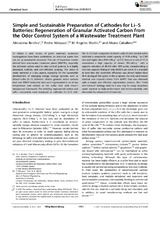Mostrar el registro sencillo del ítem
Simple and Sustainable Preparation of Cathodes for Li−S Batteries: Regeneration of Granular Activated Carbon from the Odor Control System of a Wastewater Treatment Plant
| dc.contributor.author | Benítez de la Torre, A. | |
| dc.contributor.author | Márquez, Pedro | |
| dc.contributor.author | Martín Santos, María Ángeles | |
| dc.contributor.author | Caballero, Álvaro | |
| dc.date.accessioned | 2021-10-21T07:48:18Z | |
| dc.date.available | 2021-10-21T07:48:18Z | |
| dc.date.issued | 2021 | |
| dc.identifier.uri | http://hdl.handle.net/10396/21911 | |
| dc.description.abstract | To obtain a wide variety of green materials, numerous investigations have been undertaken on industrial waste that can act as sustainable resources. The use of hazardous wastes derived from wastewater treatment plants (WWTPs), especially the activated carbon used in odor control systems, is a highly abundant, scalable, and cost-effective strategy. The reuse of waste materials is a key aspect, especially for the sustainable development of emerging energy storage systems, such as lithium-sulfur (Li−S) batteries. Herein, granular active carbons from two WWTP treatment lines were regenerated in air at low temperature and utilized as the sulfur host with micro-/mesoporous framework. The resulting regenerated carbon and sulfur composites were employed as cathodes for Li−S cells. The SL-ACt3@S composite electrode with 60 wt% loaded sulfur exhibited a remarkable initial capacity of 1100 mAh g−1 at C/10 rate and higher than 800 mAh g−1 at C/2. Even at a rate of 1C, it maintained a high capacity of almost 700 mAh g−1 with a capacity retention of 85.4 % after 350 cycles, demonstrating a very low capacity fading of only 0.042 % per cycle. It is essential to note that the coulombic efficiency was always higher than 96 % during all the cycles. In this proposal, the only used source material was expired carbon from WWTP that was obtained with a simple and effective regeneration process. This “trash into treasure” strategy leads to a new way for using hazardous waste material as high-performance and environmentally safe electrodes for advanced Li−S batteries. | es_ES |
| dc.format.mimetype | application/pdf | es_ES |
| dc.language.iso | eng | es_ES |
| dc.publisher | Wiley | es_ES |
| dc.rights | https://creativecommons.org/licenses/by-nc/4.0/ | es_ES |
| dc.source | ChemSusChem 14, 3915-3925 (2021) | es_ES |
| dc.subject | Activated carbon | es_ES |
| dc.subject | Biomass | es_ES |
| dc.subject | Lithium-sulfur batteries | es_ES |
| dc.subject | Thermal regeneration | es_ES |
| dc.subject | Wastewater treatment plant | es_ES |
| dc.title | Simple and Sustainable Preparation of Cathodes for Li−S Batteries: Regeneration of Granular Activated Carbon from the Odor Control System of a Wastewater Treatment Plant | es_ES |
| dc.type | info:eu-repo/semantics/article | es_ES |
| dc.relation.publisherversion | https://doi.org/10.1002/cssc.202101231 | es_ES |
| dc.relation.projectID | Gobierno de España. CTM2017-88723-R | es_ES |
| dc.relation.projectID | Gobierno de España. MAT2017- 87541-R | es_ES |
| dc.relation.projectID | Gobierno de España. PID2020-113931RB-I00 | es_ES |
| dc.relation.projectID | Junta de Andalucía. 1262384-R (UCO-FEDER) | es_ES |
| dc.relation.projectID | Junta de Andalucía. FQM-175 | es_ES |
| dc.relation.projectID | Junta de Andalucía. RMN-271 | es_ES |
| dc.rights.accessRights | info:eu-repo/semantics/openAccess | es_ES |

